Birthstones by the Month
The May Birthstone is Emerald
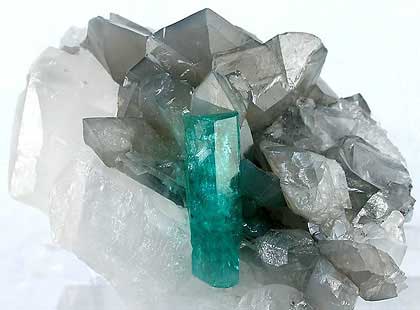
Emerald Flanked By Calcite
This is a very dramatic piece with a central emerald flanked by crystallized calcite. The emerald is of top color and glassy lustre, and is very large for such a specimen. It is entirely transparent throughout, though with internal veils as usual in a specimen. [2]
Emerald Mineral Form
A member of the beryl family along with light blue aquamarine, pink morganite, golden heliodor and pale green beryls, Emeralds are the green standard for gemstones. Emeralds display their distinctive color due to trace amounts of chromium or sometimes vanadium.
Emerald Facts
The word Emerald comes from the Greek word "smaragdos"then changed to "esmeralde"via the Old French, both of them simply meaning "green gem."The famous green has been used to describe Ireland’s grassy fields earning the country a nickname of "Emerald Isle.”
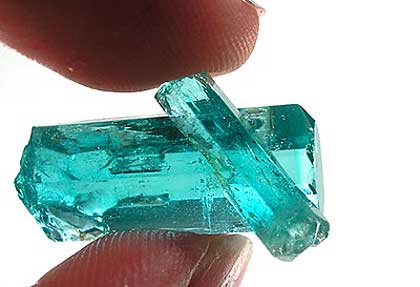
Jos Area Emeralds
This is a totally transparent, 16.1 carat, nearly flawless, light emerald green crystal with a smaller sidecar perched near the termination. The large crystal measures 2.3 cm in length. This is typical of the Jos area emeralds, in that they are gemmier but more blue-green in color than their cousins around the world.[1]
The characteristics of Emerald
The crystal formations in Emeralds are hexagonal. This formation results in double refraction, or birefringence, which means the gem refracts light in two patterns at the same time. Emerald will therefore display a distinct green main color with an often blue-green secondary hue. While Emerald has a Mohs hardness of 7.5-8 making this a fine gem for most jewelry applications, a hard strike or sudden temperature changes can cause the stone to internally crack.
Cut and Clarity for the May birthstone
The inclusions found in Emeralds were affectionately referred to as "jardin,"meaning "garden"in French. The green inclusions were considered part of the allure of the gemstone.
This precious gem even has a cut named after it, which was created to achieve the greatest optical properties without compromising the brittle nature of the stone during cutting.
Aside from the Emerald cut or other step cuts, Emeralds are commonly found in classical shapes such as pear, oval, marquise, cushion, etc. If the harvested Emerald has a large amount of inclusions, however, it may also be cut into a rounded cabochon.
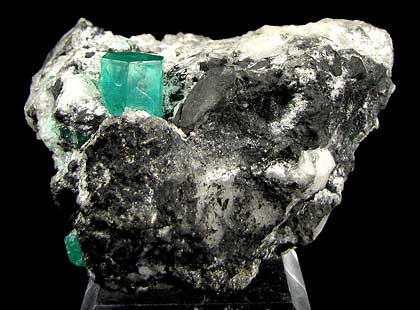
A Very Fine Emerald Specimen
A gorgeous and lustrous, 1.1 cm emerald crystal with superb color is set atop blocky, starkly contrasting calcite and shale matrix from the Coscuez Mine of Colombia. This crystal is particularly gemmy in the upper 2 mm and does not appear to have any inclusions or internal crazing. A very fine, highly representative emerald specimen. [3]
The value of Emerald
While the most famous and valuable of the green gemstones, Emeralds have a unique measurement of value. The green color is so desired, a more intense green with a lot of inclusions will actually be of higher value than a paler version with fewer inclusions.
Pristine quality is rare as inclusions are a common property of Emeralds. Some people even value Emeralds with inclusions more than high-grade clear versions since this guarantees the gem as authentic and not synthetically grown. Due to Emerald’s value throughout history as a gemstone of healing and wealth, many specimens reside in museums.
The largest carved Emerald in the world, the Mogul Mughal can be found at the Museum of Islamic Art, Doha, Qatar while the Gachala Emerald and the Patricia Emerald are housed at the Smithsonian Museum of Natural History. Fine Emeralds were originally from Colombia though they are also found all over the world including Zambia, Brazil, Zimbabwe, Madagascar, Pakistan, India, Afghanistan, Russia and North Carolina.
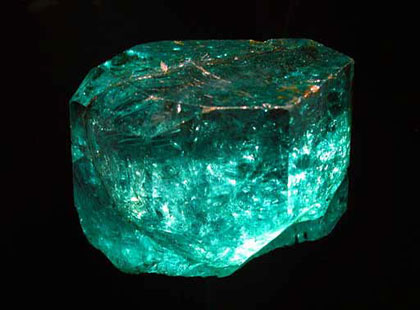
Emerald Beryl
Emerald is green beryl, its color attributed to trace amounts of chromium and sometimes vanadium. [4]
Is Emerald ever treated?
Emeralds are almost always treated with a fracture-filling technique such as oils or resins. Emeralds are heated in a cylinder filled with the colorless oil, synthetic lubricant or resin allowing the oil to penetrate and fill the inclusions. Other techniques include irradiation. Emeralds cannot be heated to a large degree as they would change to aquamarine.
When caring for Emeralds, it is never recommended to clean with an ultrasonic cleaner or harsh soap. These methods can remove the protective oiled treatment causing internal flaws to become more visible or worsen.
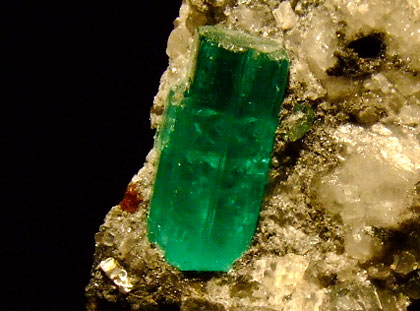
Heading
Very fine, gem quality emerald crystal from Muzo Mine, Muzo, Vasquez-Yacopí Mining District, Boyacá Department, Colombia [5]
More about Emerald the May birthstone
Throughout history Emeralds have been looked to as a symbol of life, wealth and love. The green color is often associated with the powers of nature and growth. Mined by the Ancient Egyptians, Incans and Aztecs, Emeralds have not decreased in popularity throughout the ages.
For India, since green is a holy color of Islam, Emeralds were used to bring about good luck or well-being. The Catholic Church also valued the Emerald’s green color since this hue is considered the most natural of the ceremonial colors. The Georgian and Renaissance periods as well as the more modern Art Deco scene favored richly colored gemstones including the Emerald as well as amethyst, garnet, sapphire and others.
The American Gem Society's May Birthstone page has more information to help you buy from knowledgeable and skilled jewelers and to help you make the most informed buying decision.
Image Attribution
- Rob Lavinsky, iRocks.com – CC-BY-SA-3.0 [CC BY-SA 3.0], via Wikimedia Commons
- Rob Lavinsky, iRocks.com – CC-BY-SA-3.0 [CC BY-SA 3.0], via Wikimedia Commons
- Rob Lavinsky, iRocks.com – CC-BY-SA-3.0 [CC BY-SA 3.0], via Wikimedia Commons
- By thisisbossi [CC-BY-SA-2.0] via Wikimedia Commons
- By M.M. (Own work) [CC BY-SA 3.0 or GFDL[, via Wikimedia Commons